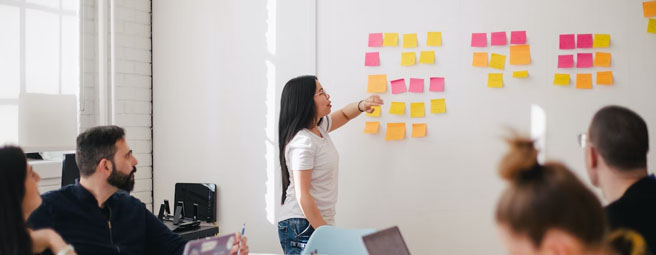
17 Best Meeting Structure Tips: In Person & Online
Meetings take up a lot of work time during the week. In the United States alone, there are around 55 million meetings every week.
The problem is not all these meetings are productive. Workers spend an average of 31 hours in unproductive meetings every month.
How can you make meetings more effective so they’re productive for everyone—both online and in person? Davinci offers these 17 tips for structuring the best meetings to optimize productivity.
10 General Meeting Tips
These are universal tips to best structure meetings of any kind; we discuss specific tips for physical and digital meetings later in the article. Utilize a combination for best results.
1. Can It Be an Email?
Before scheduling a meeting, pause and ask yourself if the subject of discussion is truly worthy of a meeting. Can time be saved via a thoughtful email or the company’s messaging app?
People are busy, and even a short meeting can disrupt workflow. Around 55% of remote workers feel a lot of meetings “could have been an email.”
2. Decide the Style of the Meeting
If you’ve decided a meeting is indeed necessary, clarify what kind of meeting it will be. Four common styles of meetings include:
The Huddle: A meeting between a leader and their team to update each other on the status of different projects. It’s scheduled consistently—often weekly—and is a team-only meeting.
The Round-Robin: A larger meeting that focuses on letting everyone get their say. People go one by one and have the option to pass if they don’t have anything to contribute. This style of meeting is good for creative discussions and brainstorming new ideas.
The Open Forum: Anyone and everyone can speak up at this type of meeting. It’s not the most organized method for business meetings, but it works well for virtual or hybrid meetings using the chat feature.
The Fishbowl: In this type of meeting, there are two circles, an inner and an outer circle. The inner circle has active participants, while the outer circle has listeners. When a listener wants to join the conversation, they swap places with someone in the inner circle.
3. Determine How Much Time is Needed
An efficient meeting is under an hour; people tend to lose focus after that. It should only last 30 minutes at most if this is a brainstorming session. Otherwise, redundancy becomes a problem.
4. Prepare a Meeting Agenda
Creating an agenda keeps the meeting on track and lets people know what will be discussed. Email the agenda ahead of time so other people can prepare as you did.
When your agenda is particularly on point, having printed copies available keeps everyone focused and following along.
5. Start On Time—Don’t Wait for Stragglers
It seems polite to wait until all members are present to start the meeting. But actually, it’s disrespectful to those who arrive on time. Late starts can lead to late ends, so you should start on time even if everyone isn’t there.
6. Ban Electronic Devices
Electronic devices should not be permitted during the meeting unless used for a specific purpose, like note-taking or hosting virtual employees. They can be distracting, and people can be tempted to multitask instead of focusing on the meeting.
7. Have Equipment Ready
Technical problems during a meeting can completely derail progress—and even end a meeting early. Before the meeting begins, make sure the TV, projector, and other tools are working properly. Doing so also ensures you have all the necessary cords for the equipment to run.
8. Balance Talking and Listening
As the leader of the meeting, it’s tempting to do all the talking. But to make a meeting worth everyone’s time, balance talking and listening. Encourage everyone to speak up, though don’t put people on the spot unless it’s truly in their (and the team’s) best interests.
9. End the Meeting with an Action Plan
By the end of the meeting, everyone should know their responsibilities and when the deadlines are. Having an action plan in place keeps everyone focused on what the meeting was for and ensures projects get completed.
10. Send Notes After the Meeting
Within 24 hours, send meeting notes to all who attended or were supposed to attend so everyone is on the same page. This also reinforces your action plan.
3 Additional Tips for Physical Meetings
There are special considerations when hosting a face-to-face meeting in addition to the factors we’ve already discussed.
1. Layout
When conducting a physical meeting, decide what room layout best suits this type of meeting. There are many different layout options available—read about those in How These Different Conference Room Layouts Can Set Your Meeting Up for Success.
2. Furniture
Take the time to ensure there are enough seats for everyone and a large enough table for everyone to take notes.
3. Accessibility
Ensure everyone can see the screen (if you use one) easily and can maneuver through the room without difficulty.
4 Additional Tips for Online Meetings
Both online and hybrid meetings present challenges, as you want everyone to feel involved even if they aren’t physically present.
1. Manage Equipment
We’ve already discussed equipment, but for hybrid meetings, it warrants a second look. Not only should you make sure all physical equipment is working properly, but make sure all virtual tools are working.
For example, can people see and hear clearly both on the computer and in the room through your video conference tool? Can you screen share so virtual employees can follow along?
2. Set Muting Rules
Most virtual employees aren’t in a soundproof space. At the beginning of the meeting, mute everyone or ask participants to mute themselves unless speaking. This minimizes distractions from background noise.
3. Look into the Camera
When listening to a remote employee, remember proper eye contact means looking at the camera, not their face.
4. Use Chat Features
Remote employees can put questions or comments in the chat without feeling silenced—or interrupting others who are speaking.
Have Productive Meetings in Davinci Spaces
Now that you know how to structure a meeting to ensure maximum productivity, it’s time to find the optimum meeting space. Davinci features a variety of spaces to hold meetings. Each rental comes with working presentation equipment—one less thing to worry about.
With thousands of locations worldwide, Davinci can help with all your meeting needs. Visit Davinci to find a meeting space near you today!

Categories
Subscribe to Our Blog
Archive

- November 2025
- October 2025
- September 2025
- August 2025
- July 2025
- June 2025
- May 2025
- April 2025
- March 2025
- February 2025
- January 2025
- December 2024
- November 2024
- October 2024
- September 2024
- August 2024
- July 2024
- June 2024
- May 2024
- April 2024
- March 2024
- February 2024
- January 2024
- December 2023
- November 2023
- October 2023
- September 2023
- August 2023
- July 2023
- June 2023
- May 2023
- April 2023
- March 2023
- February 2023
- January 2023
- December 2022
- November 2022
- October 2022
- September 2022
- August 2022
- July 2022
- June 2022
- May 2022
- April 2022
- March 2022
- February 2022
- January 2022
- December 2021
- November 2021
- October 2021
- September 2021
- August 2021
- July 2021
- June 2021
- May 2021
- April 2021
- March 2021
- February 2021
- January 2021
- December 2020
- November 2020
- October 2020
- September 2020
- August 2020
- July 2020
- June 2020
- May 2020
- April 2020
- March 2020
- February 2020
- January 2020
- December 2019
- November 2019
- October 2019
- September 2019
- August 2019
- July 2019
- June 2019
- May 2019
- April 2019
- March 2019
- February 2019
- January 2019
- December 2018
- November 2018
- October 2018
- September 2018
- August 2018
- July 2018
- June 2018
- May 2018
- April 2018
- March 2018
- February 2018
- January 2018
- December 2017
- September 2017
- June 2017
- April 2017
- October 2016
- July 2016
- May 2016
- April 2016
- February 2016
- November 2015
- September 2015
- February 2015
- January 2015
- December 2014
- November 2014
- October 2014
- August 2014
- July 2014
- July 2013
- May 2013
- February 2013
- December 2012
Talk to an expert
Want help finding the ideal meeting room? Give us a call
Book the Perfect Meeting Room Now
Find a Meeting Room








